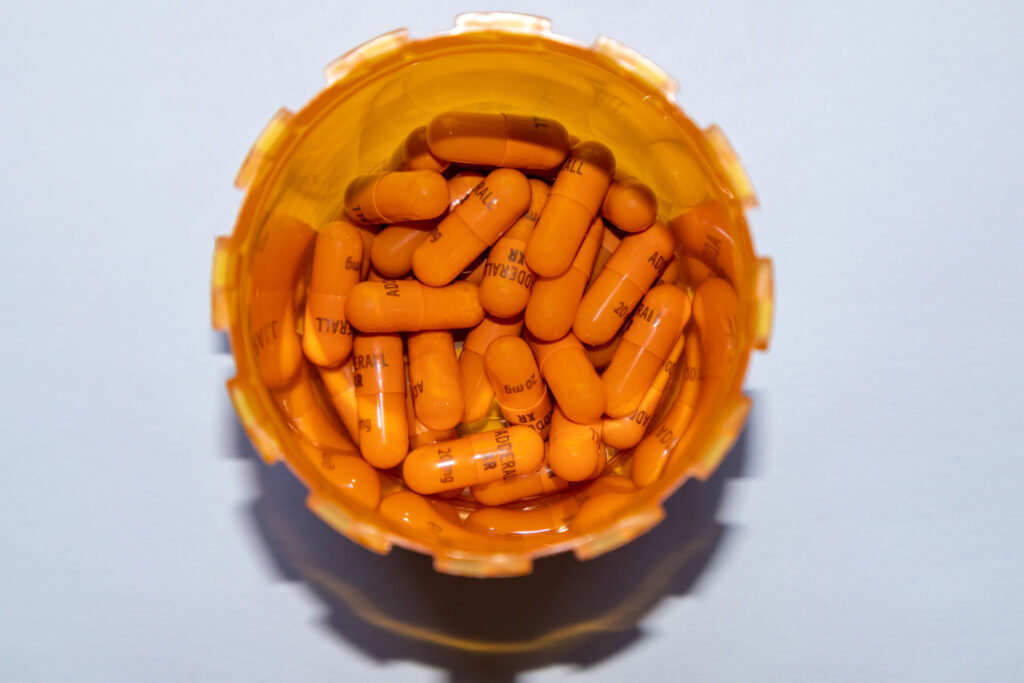Adderall and Substance Abuse Disorders
Introduction
During a child’s developmental years, psychiatrists and doctors make decisions about the wellbeing of a child and their behavior which may have deep ripple effects throughout the child’s adult life. That said, Adderall is one of the most prescribed controlled substances given to children in their developmental years (Lakhan & Kirchgessner, 2012). Adderall is a synthetic stimulant which interacts with the sympathetic and central nervous system to treat a small variety of conditions. While there is much research on Adderall itself, and its effects on the brain and behavior, there is little research on the drug’s potential to spawn Substance Use Disorders (SUDs). In fact, the potential long-term effects of this early exposure to a mind and mood-altering drug are very rarely studied at all. This is despite Adderall being suggested as a risk factor for substance involvement in youths (Tapert et al., 2002). The psychology and mental health industries owe it to their young patients, and their consenting parents, to have a better grasp on the life-long outcomes of prescribing such a serious, addicting substance. Adderall is known to become a habit-forming substance (Volkow & Swanson, 2008), making the presumed risks of early-life prescriptions only that more serious.
Review of Research
Amphetamines Are Widely Prescribed to Adolescents
Although there are many reasons for receiving an Adderall prescription from a doctor, there are some common situations where children are frequently prescribed Adderall. Attention Deficit Hyperactivity Disorder (ADHD) is one of the most common conditions afflicting children which typically sees an Adderall prescription as a solution (Feldman, 2017). To make matters more complex, there are three different types of amphetamines which can be prescribed in various combinations to achieve different short or long-acting behavior changes. Very little research exists in terms of the safety of any three of these forms of the substance in adolescents (2017). Despite this fact, Adderall is still readily prescribed to children, largely because of the academic outcomes (e.g. focus, better grades, better behavior in the classroom) (Powers et al., 2008).

Some of the only relevant research which does exist typically outlines demographic-based information about the child patients who end up prescribed Adderall for ADHD. (Zuvekas & Vitiello, 2012). In other words, these are studies which indicate (or attempt to indicate) patient trends such as age, sex, ethnicity, family income or other social statistic, and geographical location. One of the main findings of these kinds of recent studies includes highlighting the continuing, upwards trend of new Adderall prescriptions for children (2012). One thing is certain, however, and that is how common Adderall prescriptions are becoming amongst child and adolescent patients (Lakhan & Kirchgessner, 2012). Adderall is often prescribed to children as young as eight years old (Barkley et al., 1990). In fact, scheduled stimulants are reportedly mostly prescribed to children (Zuvekas & Vitiello, 2012).
Adderall Changes Brain Chemistry
Adderall works by targeting the neurotransmitter activity of dopamine and norepinephrine in the brain (Moneer et al., 2015). It is capable of changing the brain’s chemistry in terms of reward factors. These reward factors can impact motivation, emotional state, alertness, and other attributes of the mind (Moneer et al., 2015). And while there may be limited studies outlining the true addictive characteristics of Adderall, there is certainly a plethora of anecdotal evidence that addiction exists (2015). There is also a lot of empirical data which supports the concept that long-term Adderall use contributes to many brain-devised behaviors and contributions (Lautieri, 2022). Some of these affected models include sleep difficulties, inability to focus or concentrate, lack of motivation, mood swings, irritability, aggression, thoughts of suicide, paranoia, hallucinations, anxiety, panic attacks, and headaches (2022). These types of issues are known to contribute to SUDs as well (Smith & Book, 2008).
Some research has suggested that Adderall can be neurotoxic (Berman et al., 2009). These studies declare the drug creates neurobiological adaptations, which may even be permanent. Additionally, prolonged exposure of Adderall could damage components of the central nervous system. It is worth noting that the actual mechanics and parameters of Adderall’s neurotoxicity have yet to be identified. One popular theory, however, suggests that regular amphetamine use builds higher-than-normal levels of cytoplasmic dopamine. This dopamine buildup is associated with the amphetamine-mediated disarray of vesicular storage, which further leads to the excess accumulation of reactive oxygen and, ultimately, critical oxidative stress (2009). Despite all this very tangible evidence, the topic of neurotoxicity and Adderall is best summarized as ‘clarification of the neurological consequences of chronic amphetamine treatment is needed’ (Advokat, 2007). And it is clear that there is a direct link between Adderall and how the brain handles emotion (Weyandt et al., 2018).

No matter the reason an individual is prescribed Adderall, there is a proven risk-addiction factor (Berman et al., 2009). For example, clinical reports have outlined a 1 to 3 percent addiction risk for adult patients being prescribed Adderall for sleep disorders (2009). These types of risk factors could be higher for a child or adolescent population. Very little research exists on the reward effects of Adderall on children versus adults, however, some models suggest that children are more sensitive to the rewards these types of drugs provide (Schramm-Sapyta et al., 2009). And while a child’s addiction risk has not been thoroughly studied in terms of voluntarily taking more Adderall for greater reward, it has been proven that there is a defined difference between how children and adults experience drugs (2009). Some studies do exist which outline the regular use of Adderall, or the misuse of the substance, to contribute to dependency issues (Volkow & Swanson, 2008). And there are some studies which indicate the earlier an individual is introduced to substances with abuse potential, the greater their likelihood of developing SUDs or dependency issues later in life (2008).
Adderall’s Comorbidity with Other Substance Use Disorders
While there are few studies on Adderall’s tendency to increase likelihood of other substance use and SUDs in children, there is plenty of research available on the drug’s use alongside other drugs. A lot of research indicates a direct link between adult Adderall use and other drug use. One finding published in the Journal of American College Health indicated students who used Adderall were far more likely to abuse alcohol or other drugs (Baggett, 2021). This same study also highlighted the opposite trend: that students who drank heavily or used marijuana were more likely to abuse stimulants (2021). This type of correlation would suggest that Adderall might just be as much of a “gateway drug” as any other drug.
Research which directly links Adderall to the use of other substances might be slim and in need of more data, however, what does exist indicates significant relationships between Adderall use alongside other drug use. One study purported that Adderall users were more likely to consume more alcohol (doing both drugs at the same time) than individuals who only drank (Egan et al., 2014). This finding suggests a deeper problem may exist than simple comorbidity: users of Adderall are more likely to also overdo and abuse other drugs more heavily. And currently, simultaneous use of multiple drugs (including Adderall) amongst certain populations is strongly prevalent (2014).
Amongst a handful of studies, it has been determined that the co-existence of multiple dependencies is a frequent discovery in Adderall patients. One study suggests that there is a variance in terms of co-existing addiction risks between these other drugs being used alongside Adderall (Notzon et al., 2016). This study even suggests that marijuana use could decrease whereas cocaine dependence and use may increase (2016). In other words, the co-existing addiction risks will vary between substances, but the risks most certainly exist. And it does not help that almost all other substance use creates additional risk for polydrug use altogether (Martin et al., 1992).
The Problem
One increasingly pressing issue in psychiatry today is whether or not children should be prescribed stimulants to treat disorders such as ADHD (Volkow & Swanson, 2008). Stimulants have a high risk of abuse, and thus, it has even been suggested that patients treated with stimulants receive integrated substance abuse-oriented treatment protocols as well (2008). It is notable that there are already treatment protocols for patients suffering from ADHD and SUDs (Mariani & Levin, 2007); and thus, not unreasonable to suggest there should be protocols in place to help new Adderall patients (children included) better understand and cope with the changes in their risk factors for addiction and the development of SUDs which may come along with the drug. And before treatment protocols can be established, more research in terms of identifying any link between Adderall and the development of SUDs is needed.

Unfortunately, even some of the most recent reviews indicate that there is very little research in terms of the efficacy or safety of Adderall use by a child or adolescent population (Feldman, 2017). For example, one study has even been suggested that chronic Adderall use could cause cardiovascular complications (Belman et al., 2009). Other studies have indicated that there may be a high potential for other adverse effects from chronic Adderall use which have gone unexplored. And with the substance’s proven high potential for adverse effects in adults (2009), it is even more responsible to suggest more research on the drug’s potential long-term effects for children is warranted. Perhaps one of the most serious effects could be the drug’s potential to initiate or encourage the development of SUDs (early or later in life). It has already been proven that there is a population of young amphetamine addicts taking every opportunity to consume more Adderall (2009). It is not a far leap to suggest that this craving could evolve into more serious SUDs, potentially leaving the patient trapped for life in a drug-induced, addictive haze.
Some studies and research have made the suggestion that Adderall use can lead to SUDs (Wilens et al., 1997), however, not enough empirical data exists to be certain. Unfortunately, preexisting disorders (such as ADHD) may already leave an individual more susceptible to substance abuse (Marel et al., 2019). One study suggested that stimulants were among the top three (ranking number two) drugs for initiating “use to use” disorder (Florez-Salamanca et al., 2013), which essentially means going from drug to drug. Even if Adderall only encouraged the use of another drug, it is reasonable to say that new drug may be the catalyst in creating SUDs (Kollins, 2007), leaving the end outcome the same.
Purpose of Proposed Research
At least 16 million adults in the United States use prescription stimulants (Compton et al., 2018) and are potentially available for survey. It is reasonable to suggest the easiest way to determine the overall risk of additional substance addiction (or SUDs) in children prescribed Adderall on a long-term basis could be a self-reporting survey on an adolescent and adult population. Comprised of a large enough sample size, the control groups can reasonably be isolated into two categories: adolescents (13 to 17) and adults (18+). This diversity in control group will allow the presumption of some additional data in terms of how childhood Adderall use has affected individuals throughout various stages of life. The participants will be asked about their childhood Adderall use including date of first use, dosage, frequency, and last day of use (or if they are still currently using). They will also be asked about their additional drug and alcohol use, including the same cataloguing data requested of their Adderall use (start date, dosage, frequency, end date). This data will be compared with the age demographic to deliver depth in how Adderall relates to other substance use throughout the participant’s life.
Overview of Research Method
An anonymous self-reporting survey will be conducted in a group of participants who have been prescribed Adderall long-term (for at least 5 years). The anonymity of participants is imperative as it will increase the likelihood of honesty in the findings. The participants will be collected in equal age brackets, with a minimum of 80 adolescent (13-17) participants and 80 adult (18+) participants, to create a dichotomy of empirical data. The questionnaire will offer participants an opportunity to index their drug and alcohol history, including present use.
The group data should be split into two main categories: those who fell victim to SUDs after their prolonged childhood Adderall use, and those who did not. This analysis will identify any correlation between early Adderall use and long-term SUDs. Additionally, a t-test will be used to analyze the resulting survey data. This will reveal the difference of means, and ultimately the difference between the two age groups.
By further analyzing the resulting data, it may be possible to draw correlations between Adderall and the development of SUDs. It may be possible to determine the most probable age for onset of SUDs in Adderall patients. Additionally, the research could outline predictions in terms of specific substance abuse, and proposed quantities. In other words, it could be possible to predict how much of another substance a child using Adderall may be likely to use as SUDs develops. This research model can be easily scaled to include more participants in different regions to ensure the reputability of the findings.
Conclusion

The high prevalence of polydrug use amongst those suffering from mental disorders of any kind is alarming (Bierut et al., 2008). Adderall prescriptions being given to children is one easily measurable relationship which would reveal any connection to the development of SUDs. Too much potential for Adderall abuse exists amongst children (Lakhan & Kirchgessner, 2012) to ignore the concept that early Adderall prescriptions could be a precursor for the development of SUDs. And not enough empirical data exists studying the early use of Adderall and the development of SUDs. To find a potential link between an adolescent or adult SUDs victim and a childhood Adderall prescription, more research is required. This proposed research would further analyze a potential connection between childhood Adderall use and the development of SUDs during childhood or later in life.
References
Advokat, C. (2007). Literature Review: Update on Amphetamine Neurotoxicity and Its Relevance to the Treatment of ADHD. Journal of Attention Disorders. Vol. 11(1). Pp. 8–16. DOI: https://doi.org/10.1177/1087054706295605
Baggett, L., (2021). Misuse of Stimulants Linked to Other Drug Abuse. Health and Wellness: UGA Today. Retrieved from: https://news.uga.edu/misuse-of-stimulants-linked-to-other-drug-abuse/
Barkley, R., Fischer, M., Edelbrock, C., Smallish, L., (1990). The Adolescent Outcome of Hyperactive Children Diagnosed by Research Criteria: I. An 8-Year Prospective Follow-up Study. Journal of the American Academy of Child & Adolescent Psychiatry. Vol. 29(4). Pp. 546-557. DOI: https://doi.org/10.1097/00004583-199007000-00007.
Berman, S., Kuczenski, R., McCracken, J. et al., (2009). Potential adverse effects of amphetamine treatment on brain and behavior: a review. Mol Psychiatry. Vol. 14. Pp. 123–142. DOI: https://doi.org/10.1038/mp.2008.90
Bierut, L., Strickland, J., Thompson, J., Afful, S., Cottler, L., (2008). Drug use and dependence in cocaine dependent subjects, community-based individuals, and their siblings. Drug and Alcohol Dependence. Vol. 95(1–2). Pp. 14-22. DOI: https://doi.org/10.1016/j.drugalcdep.2007.11.023.
Compton, W., Han, B., Blanco, C., Johnson, K., and Jones, C., (2018). Prevalence and Correlates of Prescription Stimulant Use, Misuse, Use Disorders, and Motivations for Misuse Among Adults in the United States. American Journal of Psychiatry. Vol. 175(8). Pp. 741-755.
Egan, K. L., Reboussin, B. A., Blocker, J. N., Wolfson, M., & Sutfin, E. L. (2013). Simultaneous use of non-medical ADHD prescription stimulants and alcohol among undergraduate students. Drug and alcohol dependence. Vol. 131(1-2). Pp. 71–77. DOI: https://doi.org/10.1016/j.drugalcdep.2012.12.004
Feldman M. E. (2017). Amphetamines for attention deficit hyperactivity disorder in children and adolescents. Paediatrics & child health. Vol. 22(5). Pp. 288–289. DOI: https://doi.org/10.1093/pch/pxx084
Flórez-Salamanca, L., Secades-Villa, R., Hasin, D. S., Cottler, L., Wang, S., Grant, B. F., & Blanco, C. (2013). Probability and predictors of transition from abuse to dependence on alcohol, cannabis, and cocaine: results from the National Epidemiologic Survey on Alcohol and Related Conditions. The American journal of drug and alcohol abuse. Vol. 39(3). Pp. 168-179. DOI: https://doi.org/10.3109/00952990.2013.772618
Kollins, S. H. (2008). ADHD, Substance Use Disorders, and Psychostimulant Treatment: Current Literature and Treatment Guidelines. Journal of Attention Disorders. Vol. 12(2). Pp. 115–125. DOI: https://doi.org/10.1177/1087054707311654
Lakhan, S. E., & Kirchgessner, A. (2012). Prescription stimulants in individuals with and without attention deficit hyperactivity disorder: misuse, cognitive impact, and adverse effects. Brain and behavior. Vol. 2(5). Pp. 661–677. DOI: https://doi.org/10.1002/brb3.78
Marel, C., Sunderland, M., Mills, K., Slade, T., Teesson, and Chapman, C., (2019). Conditional probabilities of substance use disorders and associated risk factors: Progression from first use to use disorder on alcohol, cannabis, stimulants, sedatives and opioids. Drug and Alcohol Dependence. Vol. 194. Pp. 136-142. DOI: https://doi.org/10.1016/j.drugalcdep.2018.10.010.
Mariani, J. J., & Levin, F. R. (2007). Treatment strategies for co-occurring ADHD and substance use disorders. The American Journal on Addictions. Vol. 16. Suppl 1(Suppl 1). Pp. 45–56. DOI: https://doi.org/10.1080/10550490601082783
Martin, C., Clifford, P., Clapper, R., (1992). Patterns and predictors of simultaneous and concurrent use of alcohol, tobacco, marijuana, and hallucinogens in first-year college students. Journal of Substance Abuse. Vol. 4(3). Pp. 319-326. DOI: https://doi.org/10.1016/0899-3289(92)90039-Z.
Moneer, O., Lawson, J., Joern, J., and Mensah, T., (2014). Addicted to Adderall. CUSJ. Vol. 9. Pp. 8. Retrieved from: https://journals.library.columbia.edu/index.php/cusj/article/download/5571/2693/9671
Notzon, D. P., Mariani, J. J., Pavlicova, M., Glass, A., Mahony, A. L., Brooks, D. J., Grabowski, J., & Levin, F. R. (2016). Mixed-amphetamine salts increase abstinence from marijuana in patients with co-occurring attention-deficit/hyperactivity disorder and cocaine dependence. The American journal on addictions. Vol. 25(8). Pp. 666–672. DOI: https://doi.org/10.1111/ajad.12467
Powers, R. L., Marks, D. J., Miller, C. J., Newcorn, J. H., & Halperin, J. M. (2008). Stimulant treatment in children with attention-deficit/hyperactivity disorder moderates adolescent academic outcome. Journal of child and adolescent psychopharmacology. Vol. 18(5). Pp. 449–459. DOI: https://doi.org/10.1089/cap.2008.021
Schramm-Sapyta, N. L., Walker, Q. D., Caster, J. M., Levin, E. D., & Kuhn, C. M. (2009). Are adolescents more vulnerable to drug addiction than adults? Evidence from animal models. Psychopharmacology. Vol. 206(1). Pp. 1–21. DOI: https://doi.org/10.1007/s00213-009-1585-5
Smith, J. P., & Book, S. W. (2008). Anxiety and Substance Use Disorders: A Review. The Psychiatric times. Vol. 25(10). Pp. 19–23. PMID: 20640182
Tapert, S., Baratta, M., Abrantes, A., and Brown, S., (2002). Attention dysfunction predicts substance involvement in community youths. J Am Acad Child Adolesc Psychiatry. Vol. 41(6) Pp.680-6. DOI: 10.1097/00004583-200206000-00007. PMID: 12049442.
Volkow, N. D., & Swanson, J. M. (2008). Does childhood treatment of ADHD with stimulant medication affect substance abuse in adulthood?. The American Journal of Psychiatry. Vol. 165(5). Pp. 553–555. DOI: https://doi.org/10.1176/appi.ajp.2008.08020237
Weyandt, L. L., White, T. L., Gudmundsdottir, B. G., Nitenson, A. Z., Rathkey, E. S., De Leon, K. A., & Bjorn, S. A. (2018). Neurocognitive, Autonomic, and Mood Effects of Adderall: A Pilot Study of Healthy College Students. Pharmacy (Basel, Switzerland). Vol. 6(3). Pp. 58. DOI: https://doi.org/10.3390/pharmacy6030058
Wilens, T., Biederman, J., Mick E, Faraone S., Spencer T., (1997). Attention deficit hyperactivity disorder (ADHD) is associated with early onset substance use disorders. J Nerv Ment Dis. Vol. 185(8). Pp. 475-82. DOI: 10.1097/00005053-199708000-00001. PMID: 9284860.
Zuvekas, S. H., & Vitiello, B. (2012). Stimulant medication use in children: a 12-year perspective. The American journal of psychiatry. Vol. 169(2). Pp. 160–166. DOI: https://doi.org/10.1176/appi.ajp.2011.11030387
Zuvekas, S. H., & Vitiello, B. (2012). Stimulant medication use in children: a 12-year perspective. The American Journal of Psychiatry. Vol. 169(2). Pp. 160–166. DOI: https://doi.org/10.1176/appi.ajp.2011.11030387




